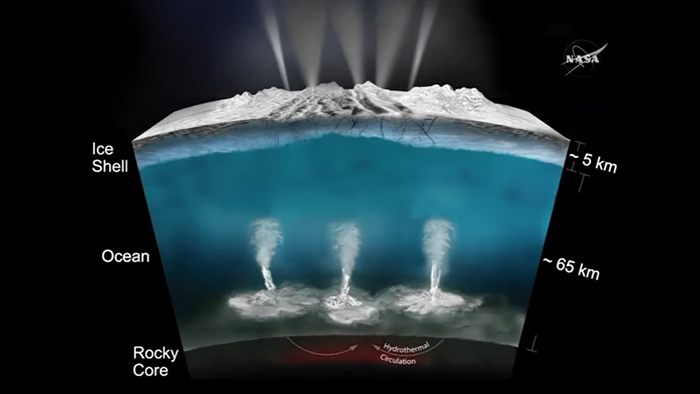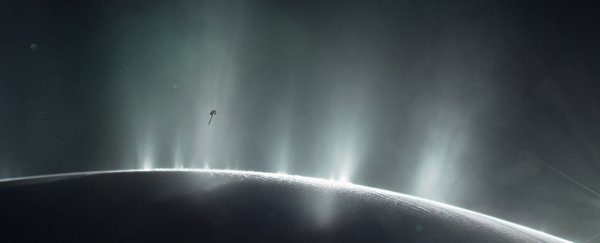NASA scientists have found more evidence that Saturn's icy moon Enceladus could support life: the presence of hydrogen molecules in huge geysers of water shooting up from the surface.
The discovery of this chemical energy source means Enceladus is currently the very best place to look for life outside of Earth, with conditions that could be just right for alien microbes to survive.
"This is the closest we've come, so far, to identifying a place with some of the ingredients needed for a habitable environment," said Thomas Zurbuchen, associate administrator for NASA's Science Mission Directorate.
We've got the Cassini spacecraft to thank for the new findings, as the probe has been busy taking measurements around Saturn and Enceladus since 2004.
An analysis of the samples Cassini took two years ago, as it flew through the geysers of Enceladus, have now revealed these tell-tale hydrogen molecules.
The hydrogen strongly suggests that hydrothermal activity is going on in the ocean below the surface of Enceladus, and because some of the most basic lifeforms on Earth thrive in ocean vents like the ones Cassini has been flying over, the same type of life could exist on Saturn's moon.
"This doesn't tell us whether life is there or not," astronomer Jonathan Lunine, from the Cornell Centre for Astrophysics and Planetary Science, told Gizmodo.
"It just makes the case for the ocean being able to support life that much stronger."
 NASA/JPL-Caltech
NASA/JPL-Caltech
We've suspected for a while that water is being heated below the surface of Enceladus, but the presence of hydrogen just about confirms it: the reaction of certain minerals with hot rocks is the most likely explanation for the large amounts of hydrogen found by Cassini.
Meanwhile, the hydrogen discovery also makes it more likely that methane is being produced from carbon dioxide on the moon, a process known as methanogenesis.
The hydrogen and the methanogenesis could well provide a food source for microbes, experts think, in the same way it does on Earth.
In other words, Earth's microbes could probably live on Enceladus.
But, the hydrogen is so abundant that it might also mean there are no microbes around to eat it up, NASA said in its press conference today, or that microbes are there but only in a very small number.
For the time being we just don't know – but the ingredients for life are there, based on the research published today.
"The discovery of native molecular hydrogen [H2] completes the set of what I would call the 'basic' requirements for life as we know it: liquid water, organic molecules, minerals, and an accessible source of 'free' energy," Lunine explained to Gizmodo.
"The H2 discovery completes the case for going back to Enceladus to look for life."
At the same time, scientists working with the Hubble telescope say they've found more evidence that another of Jupiter's moons, Europa, is spurting out watery jets of its own, giving us yet another potential spot where life might develop.
Researchers have suggested Europa has geysers of its own before, but this latest evidence is more compelling. For the time being though, Enceladus remains the most promising place to look for life.
Sadly, we soon have to say goodbye to Cassini after all the fantastic work it's been doing in studying Saturn and its moons.
The spacecraft will crash into Saturn in September, after a job well done.
The findings have now been published in Science.
